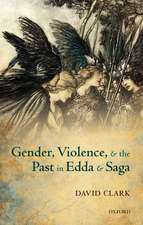Pindar's Eyes: Visual and Material Culture in Epinician Poetry
Autor David Fearnen Limba Engleză Hardback – 21 sep 2017
Preț: 657.14 lei
Preț vechi: 943.51 lei
-30% Nou
Puncte Express: 986
Preț estimativ în valută:
125.74€ • 131.64$ • 104.04£
125.74€ • 131.64$ • 104.04£
Carte tipărită la comandă
Livrare economică 27 martie-02 aprilie
Preluare comenzi: 021 569.72.76
Specificații
ISBN-13: 9780198746379
ISBN-10: 0198746377
Pagini: 330
Dimensiuni: 143 x 222 x 25 mm
Greutate: 0.54 kg
Editura: OUP OXFORD
Colecția OUP Oxford
Locul publicării:Oxford, United Kingdom
ISBN-10: 0198746377
Pagini: 330
Dimensiuni: 143 x 222 x 25 mm
Greutate: 0.54 kg
Editura: OUP OXFORD
Colecția OUP Oxford
Locul publicării:Oxford, United Kingdom
Recenzii
The engagement with Pindaric scholarship is thorough, often explained in lengthy footnotes. The readings derive from sound translations, arguments and interpretations, whatever will be thought of particular points. More importantly, these readings are exciting because they push our approach to Pindar beyond the rehash of scholarly quagmires and current trends. In many ways, these studies offer great value, individually and as a whole, that strives toward a new, art-historically informed approach to Pindar in which meaning derives from the poetics.
the book is rich in insightful and enjoyable analyses, such as the reading of Nemean 8, and some general observations about Pindar's poetic personality which makes Fearn's approach thought-provoking and ground-breaking in Pindaric scholarship... Fearn's book is a valuable study of the complex Pindaric attitude to visual culture.
This interdisciplinary work provides a new understanding of Pindar's difficult texts (Nemean 5, Nemean 8, and Pythian 1 are the examples chosen) and their effect on his audiences, illuminating also the ways in which Pindar was received, for example, by Herodotus. The book is rich in ideas about text and image, ritual and poetry, ekphrasis and the lyric "I," and many other Pindaric topics. But above all, Fearns convincingly demonstrates the continuities between lyric poetry and tragedy, and ritual and visual culture. ... Summing Up: Recommended. Upper-division undergraduates through faculty.
the book is rich in insightful and enjoyable analyses, such as the reading of Nemean 8, and some general observations about Pindar's poetic personality which makes Fearn's approach thought-provoking and ground-breaking in Pindaric scholarship... Fearn's book is a valuable study of the complex Pindaric attitude to visual culture.
This interdisciplinary work provides a new understanding of Pindar's difficult texts (Nemean 5, Nemean 8, and Pythian 1 are the examples chosen) and their effect on his audiences, illuminating also the ways in which Pindar was received, for example, by Herodotus. The book is rich in ideas about text and image, ritual and poetry, ekphrasis and the lyric "I," and many other Pindaric topics. But above all, Fearns convincingly demonstrates the continuities between lyric poetry and tragedy, and ritual and visual culture. ... Summing Up: Recommended. Upper-division undergraduates through faculty.
Notă biografică
David Fearn is Reader in Greek Literature at the University of Warwick. His research focuses on the poetics, aesthetics, and the socio-political contextualization and reception of archaic and classical Greek literature, and of lyric poetry in particular, though he is also interested in classical historiography, rhetoric, and ancient aesthetics more broadly. His first book, Bacchylides: Politics, Performance, Poetic Tradition (OUP, 2007), sought to rehabilitate the reputation of this underappreciated poet. He has also edited a collection of essays entitled Aegina: Contexts for Choral Lyric Poetry. Myth, History, and Identity in the Fifth Century BC (OUP, 2011) discussing the interrelation of poetry and culture on the Greek island of Aegina.

















